United States Electric Vehicle Battery Materials Market Size
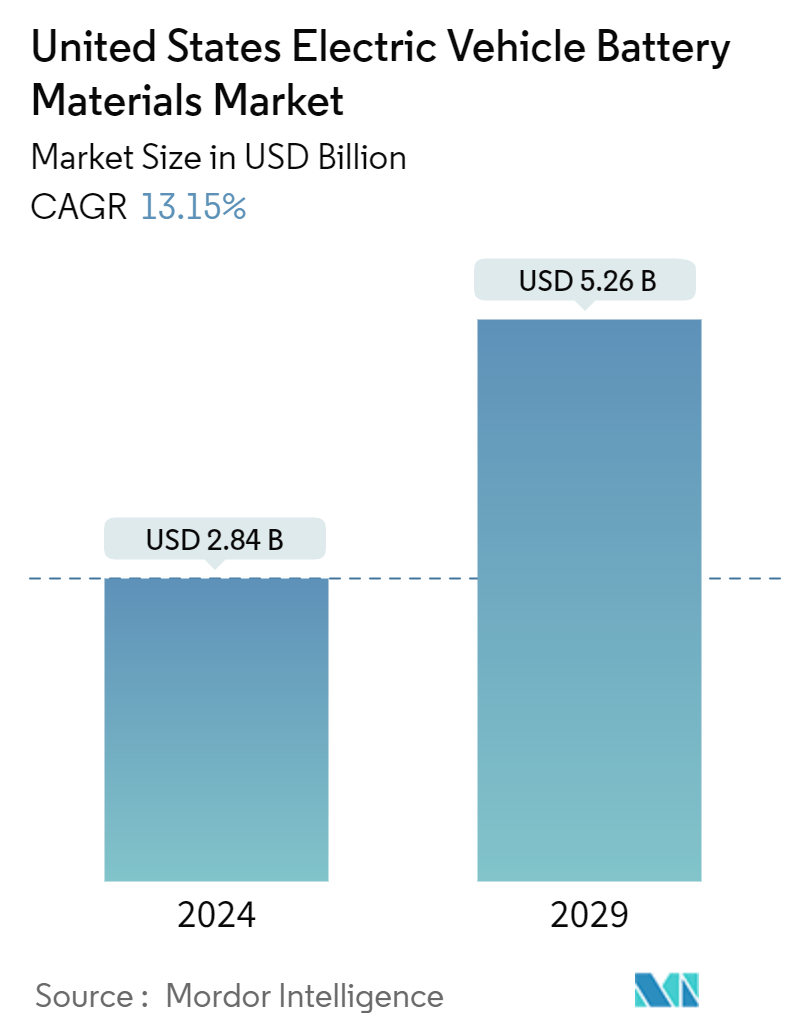
| Study Period | 2019 - 2029 |
| Base Year For Estimation | 2023 |
| Market Size (2024) | USD 2.84 Billion |
| Market Size (2029) | USD 5.26 Billion |
| CAGR (2024 - 2029) | 13.15 % |
| Market Concentration | High |
Major Players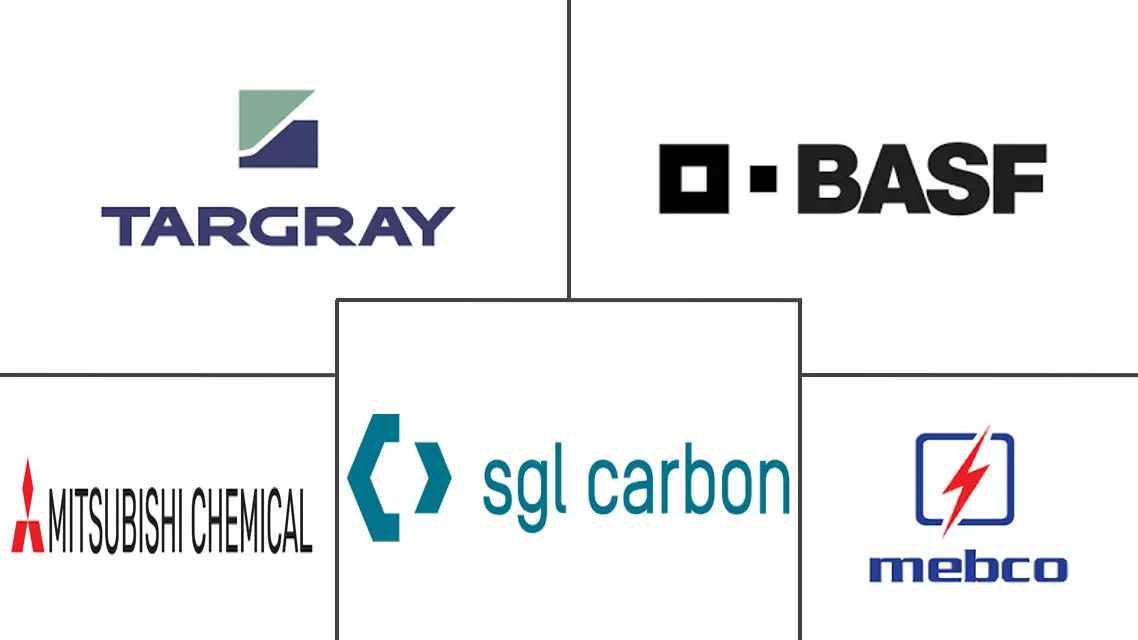
*Disclaimer: Major Players sorted in no particular order |
United States Electric Vehicle Battery Materials Market Analysis
The United States Electric Vehicle Battery Materials Market size is estimated at USD 2.84 billion in 2024, and is expected to reach USD 5.26 billion by 2029, at a CAGR of 13.15% during the forecast period (2024-2029).
- Over the medium term, factors such as rising growth in electric vehicle infrastructure and supportive government policies and regulations are expected to be among the most significant drivers for the United States Electric Vehicle Battery Materials Market during the forecast period.
- On the other hand, the lack of raw materials production, leading to heavy reliance on imports, poses a threat to the United States Electric Vehicle Battery Materials Market during the forecast period.
- Nevertheless, continued efforts are being made to develop advanced battery technology, which is expected to create several opportunities for the market in the future.
United States Electric Vehicle Battery Materials Market Trends
Lithium-ion Battery to Dominate the Market
- As the global community intensifies its focus on reducing greenhouse gas emissions, the United States has emerged as a significant player in the adoption and innovation of lithium-ion batteries, which are integral to the functionality and efficiency of electric vehicles. Several key factors, including government incentives, advancements in battery technology, and strategic investments by major automotive manufacturers, fuel this segment's growth.
- Continuous research and development in this sector have significantly enhanced battery performance, reduced costs, and bolstered safety measures. These advancements have made batteries more efficient and reliable. As a result, the sector is poised for substantial growth in the coming years.
- For instance, in March 2023, engineers at Purdue University pioneered a novel composite material designed for lithium-ion batteries, surpassing the safety benchmarks set by conventional solid polymer electrolyte (SPE) technologies. This patent-pending material, developed by Pol, boasts a 4.8-volt voltage window, an impressive ionic conductivity of 2.4*104 micro siemens, and remarkable thermal stability up to 330 degrees Celsius. Notably, it also demonstrates heightened resistance to cell damage, significantly elevating overall safety standards.
- Lithium-ion batteries, known for their high energy density, extended cycle life, and consistent power output, stand as the cornerstone of contemporary electric vehicles. These batteries have revolutionized the automotive industry by enabling longer driving ranges and faster charging times. Additionally, their lightweight nature contributes to the overall efficiency and performance of electric vehicles.
- Technical data sheets reveal that lithium-ion batteries boast a specific energy density ranging from 90 to 190 Wh/kg. This marks a substantial leap, with lithium-ion batteries offering nearly 2.5 times the energy density of lead-acid batteries and over 1.5 times that of NiMH batteries. Consequently, lithium-ion batteries are increasingly preferred in various applications due to their superior performance.
- Government policies and incentives play a crucial role in propelling the lithium-ion battery segment forward. Federal and state-level initiatives, such as tax credits for electric vehicle purchases and funding for battery research and development, provide a conducive environment for market growth. These policies not only incentivize consumers to adopt electric vehicles but also encourage companies to invest in advanced battery technologies and manufacturing capabilities.
- Therefore, cosnidering such scenario, the lithium-ion battery segment is expected to dominate the market during the forecasted period.
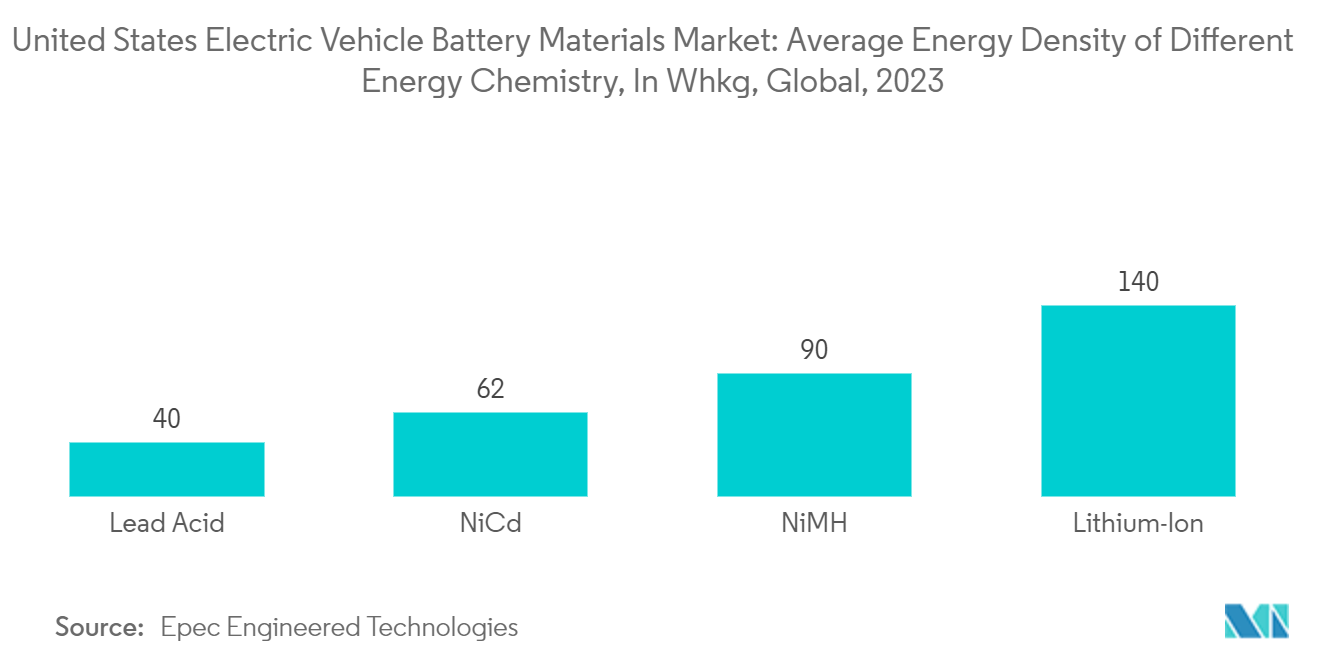
Growing Electric Vehicle Infrastructure to Drive the Market
- The rapid expansion of electric vehicle infrastructure across the United States is set to significantly boost the electric vehicle battery materials market. The proliferation of charging stations in urban, suburban, and rural locales not only enhances logistics but also plays a crucial role in bolstering consumer confidence and accelerating electric vehicle adoption.
- Data from the United States Alternative Fuels Data Center reveals a striking increase in electric vehicle charging ports. Between 2022 and 2023, these ports saw a growth of over 21.6%. Furthermore, from 2011 to 2023, the average annual growth rate stood at an impressive 300%, highlighting the surging adoption of electric vehicles in the U.S., a trend further supported by ongoing government initiatives.
- As recharging becomes increasingly convenient and accessible, concerns about range anxiety—a major hurdle for potential electric vehicle buyers—diminish. This shift creates a more conducive environment for electric vehicle adoption. Such infrastructural advancements demand a corresponding increase in the production and supply of battery materials. Key components like lithium, cobalt, and nickel are essential for ensuring the performance and reliability of electric vehicle batteries.
- In a notable move in November 2023, the United States Department of Energy (DOE) announced an allocation of up to USD 3.5 billion from the Infrastructure Law. This funding is strategically directed towards boosting the production of advanced batteries and their essential materials domestically. The focus encompasses battery-grade processed critical minerals, precursor materials, components, and the manufacturing of cells and packs. Such initiatives are crucial for strengthening the future of clean energy sectors, especially in renewable energy and electric vehicles.
- Technological innovations in charging infrastructure are also pivotal in shaping the electric vehicle battery materials market. Breakthroughs like ultra-fast charging stations, wireless charging, and vehicle-to-grid (V2G) technologies not only elevate user experience but also set new benchmarks for battery performance and composition.
- For instance, ultra-fast charging stations demand batteries capable of withstanding higher power inputs and faster charge cycles, all while ensuring longevity and safety. This necessity propels ongoing research and development in battery chemistry and materials science, paving the way for advanced materials and enhanced battery designs.
- Given these dynamics, the expanding electric vehicle infrastructure in the United States. is poised to drive the market in the coming years.
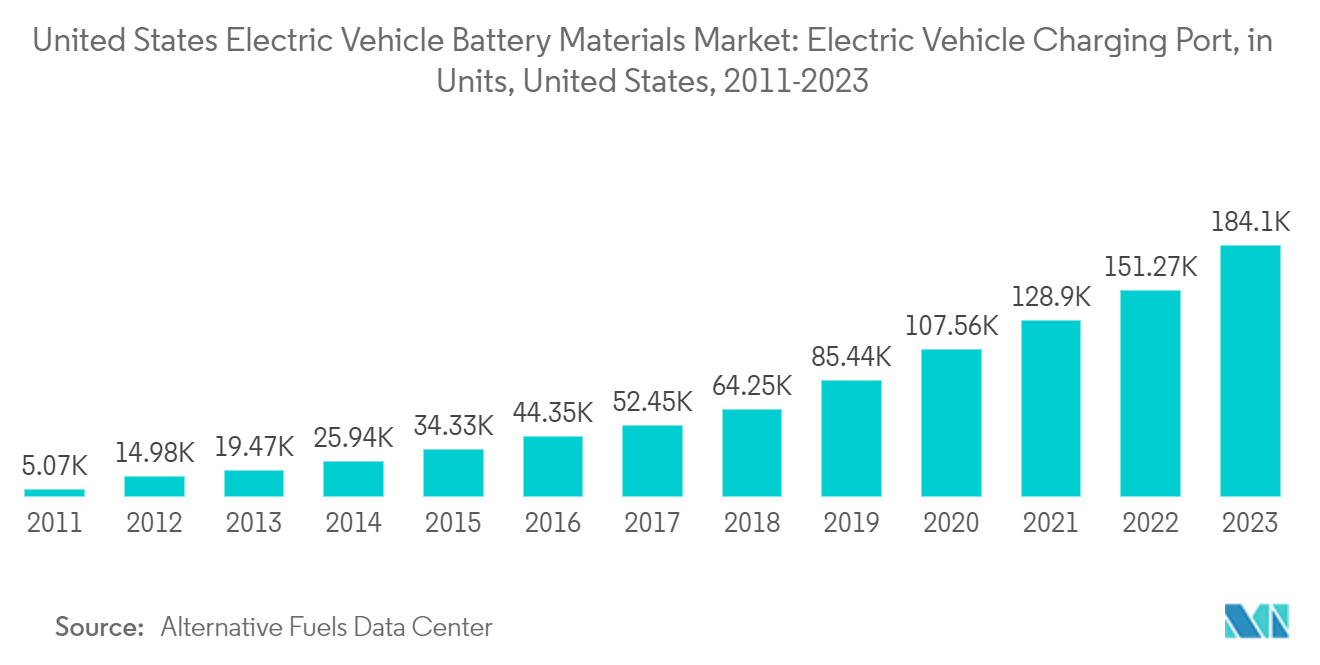
United States Electric Vehicle Battery Materials Industry Overview
The United States Electric Vehicle Battery Materials Market is semi-consolidated. Some of the key players in this market (in no particular order) are Targray Technology International Inc., BASF SE, Mitsubishi Chemical Group Corporation, UBE Corporation, and Umicore SA.
United States Electric Vehicle Battery Materials Market Leaders
-
Targray Technology International Inc.
-
BASF SE
-
Mitsubishi Chemical Group Corporation
-
UBE Corporation
-
Umicore
*Disclaimer: Major Players sorted in no particular order
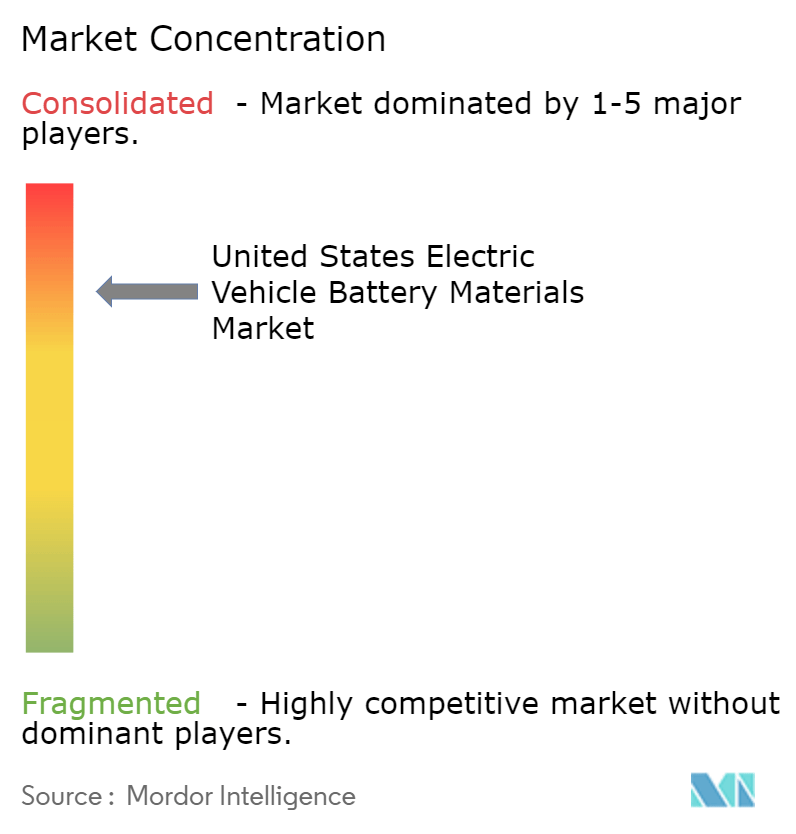
United States Electric Vehicle Battery Materials Market News
- July 2024: Amplify Cell Technologies, a collaboration between Accelera, Daimler Trucks & Buses US Holding LLC, and PACCAR commenced construction at its cutting-edge battery cell manufacturing plant in Marshall County, Mississippi. Spanning 500 acres, the site will host a two million-square-foot, eco-friendly facility capable of producing 21 gigawatt hours (GWh) of lithium-iron-phosphate (LFP) battery cells and associated battery materials annually. Amplify is set to kick off its battery cell production in 2027.
- September 2023: Lawrence Berkeley National Laboratory (Berkeley Lab) was spearheading a group of top battery scientists to fast-track the market entry of a novel battery cathode material known as DRX, short for "disordered rock salt." These DRX cathodes boast the potential to offer batteries greater energy density compared to the prevalent nickel and cobalt-based cathodes in lithium-ion batteries, both of which face severe supply shortages.
United States Electric Vehicle Battery Materials Market Report - Table of Contents
1. INTRODUCTION
1.1 Scope of the Study
1.2 Market Definition
1.3 Study Assumptions
2. EXECUTIVE SUMMARY
3. RESEARCH METHODOLOGY
4. MARKET OVERVIEW
4.1 Introduction
4.2 Market Size and Demand Forecast in USD, till 2029
4.3 Recent Trends and Developments
4.4 Government Policies and Regulations
4.5 Market Dynamics
4.5.1 Drivers
4.5.1.1 Growing Electric Vehicle Infrastructure
4.5.1.2 Supportive Government Policies and Regulations
4.5.2 Restraints
4.5.2.1 Dependence on Raw Material Supply
4.6 Supply Chain Analysis
4.7 PESTLE Analysis
4.8 Investment Analysis
5. MARKET SEGMENTATION
5.1 Battery Type
5.1.1 Lithium-ion Battery
5.1.2 Lead-Acid Battery
5.1.3 Others
5.2 Material
5.2.1 Cathode
5.2.2 Anode
5.2.3 Electrolyte
5.2.4 Separator
5.2.5 Others
6. COMPETITIVE LANDSCAPE
6.1 Mergers and Acquisitions, Joint Ventures, Collaborations, and Agreements
6.2 Strategies Adopted by Leading Players
6.3 Company Profiles
6.3.1 Targray Technology International Inc.
6.3.2 BASF SE
6.3.3 Mitsubishi Chemical Group Corporation
6.3.4 UBE Corporation
6.3.5 Umicore SA
6.3.6 Sumitomo Chemical Co., Ltd.
6.3.7 Nichia Corporation
6.3.8 ENTEK International LLC
6.3.9 Arkema SA
6.3.10 Kureha Corporation
- *List Not Exhaustive
6.4 List of Other Prominent Companies
6.5 Market Ranking/Share (%) Analysis
7. MARKET OPPORTUNITIES AND FUTURE TRENDS
7.1 Advancements in Battery Technology
United States Electric Vehicle Battery Materials Industry Segmentation
Electric vehicle battery materials refer to the raw materials and components used in the manufacturing of batteries for electric vehicles (EVs). The cathode, anode, electrolyte, and separator are key components of these batteries, each requiring specific materials to function effectively. The availability, cost, and sustainability of these materials are crucial factors influencing the production and advancement of electric vehicle batteries.
The United States Electric Vehicle Battery Materials Market is segmented by battery type and material. By battery type, the market is divided into Lithium-ion Batteries, Lead-Acid Batteries, and Others. By material, it is divided into Cathode, Anode, Electrolyte, and Separator. The report also covers the size and forecasts for the Electric Vehicle Battery Materials Markets across major regions. The market sizing and forecasts have been done for each segment based on revenue (USD).
| Battery Type | |
| Lithium-ion Battery | |
| Lead-Acid Battery | |
| Others |
| Material | |
| Cathode | |
| Anode | |
| Electrolyte | |
| Separator | |
| Others |
United States Electric Vehicle Battery Materials Market Research FAQs
How big is the United States Electric Vehicle Battery Materials Market?
The United States Electric Vehicle Battery Materials Market size is expected to reach USD 2.84 billion in 2024 and grow at a CAGR of 13.15% to reach USD 5.26 billion by 2029.
What is the current United States Electric Vehicle Battery Materials Market size?
In 2024, the United States Electric Vehicle Battery Materials Market size is expected to reach USD 2.84 billion.
Who are the key players in United States Electric Vehicle Battery Materials Market?
Targray Technology International Inc., BASF SE, Mitsubishi Chemical Group Corporation, UBE Corporation and Umicore are the major companies operating in the United States Electric Vehicle Battery Materials Market.
What years does this United States Electric Vehicle Battery Materials Market cover, and what was the market size in 2023?
In 2023, the United States Electric Vehicle Battery Materials Market size was estimated at USD 2.47 billion. The report covers the United States Electric Vehicle Battery Materials Market historical market size for years: 2019, 2020, 2021, 2022 and 2023. The report also forecasts the United States Electric Vehicle Battery Materials Market size for years: 2024, 2025, 2026, 2027, 2028 and 2029.
United States Electric Vehicle Battery Materials Industry Report
Statistics for the 2024 United States Electric Vehicle Battery Materials market share, size and revenue growth rate, created by Mordor Intelligence™ Industry Reports. United States Electric Vehicle Battery Materials analysis includes a market forecast outlook for 2024 to 2029 and historical overview. Get a sample of this industry analysis as a free report PDF download.



